Reflections, 2008
Posted in Uncategorized on December 30 2008, by Plant Talk

Inside The New York Botanical Garden
Posted in Uncategorized on December 30 2008, by Plant Talk
Posted in Gardening Tips on December 29 2008, by Sonia Uyterhoeven
Looking Back at the Year
 Sonia Uyterhoeven is Gardener for Public Education at The New York Botanical Garden.
Sonia Uyterhoeven is Gardener for Public Education at The New York Botanical Garden.
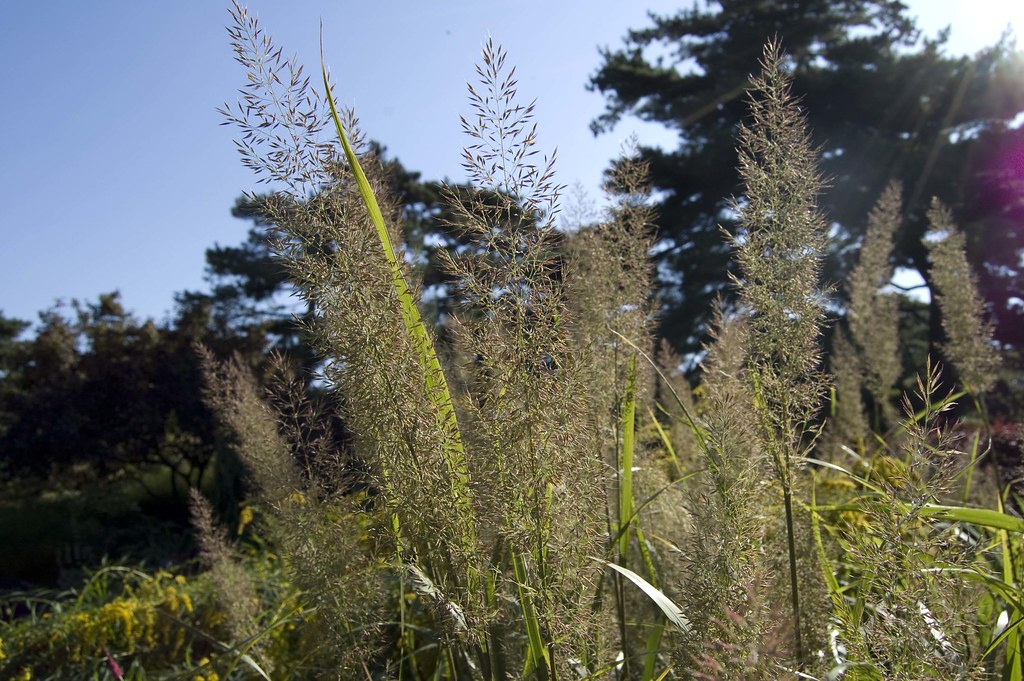 I was fortunate enough to spend two weeks in the Southeast of England this past July. As I toured around a handful of gardens, one thing that made a lasting impression was the size of the plants. With their cool summers and ample rainfall, perennials that grow three feet tall in the New York area were happily stretching up to four or five feet.
I was fortunate enough to spend two weeks in the Southeast of England this past July. As I toured around a handful of gardens, one thing that made a lasting impression was the size of the plants. With their cool summers and ample rainfall, perennials that grow three feet tall in the New York area were happily stretching up to four or five feet.
On this side of the pond the past year felt distinctly British. Spring lasted for more than a quick two-week spell with the cool weather and rain that extended well into May. July certainly had periods that were hot and the rains came infrequently in heavy downpours; the tropical plants in the Garden took notice and jumped into their full glory. August surprised me. Instead of the stifling heat and insufferable humidity that I have grown accustomed to, it was pleasant. The intense heat never came.
These are the moments that I wish I had a crystal ball. Had I known this ahead of time, I would have filled my perennial borders with lupines, penstemons, and delphiniums. I would have also cut back some of my larger, floppier customers such as the Montauk daisy (Nipponantheum) even harder than I normally do.
The ornamental grasses grew taller than I was accustomed to and needed more staking than in previous years. Many plants doubled in size and spread happily through the garden. My catmint (Nepeta) lost its sense of time and did not know when to stop flowering. Along with the lavender, it sent up sporadic blooms through the summer and well into fall. My Virginia sweetspire (Itea) decided that fall had come early and started to show its fiery reds as early as mid-August.
Observation is one of the finest tools that gardeners can posses. Gardeners not only work with plants, they work with nature. Observing nature and watching how changes in the environment directs and affects the growth and the cycles in the garden is one of the greatest gifts. It teaches gardeners more about plants than any textbook ever could.
Posted in Uncategorized on December 23 2008, by Plant Talk
Posted in Gardening Tips on December 22 2008, by Sonia Uyterhoeven
Lessons in Biodiversity and Sense of Place
 Sonia Uyterhoeven is Gardener for Public Education at The New York Botanical Garden.
Sonia Uyterhoeven is Gardener for Public Education at The New York Botanical Garden.
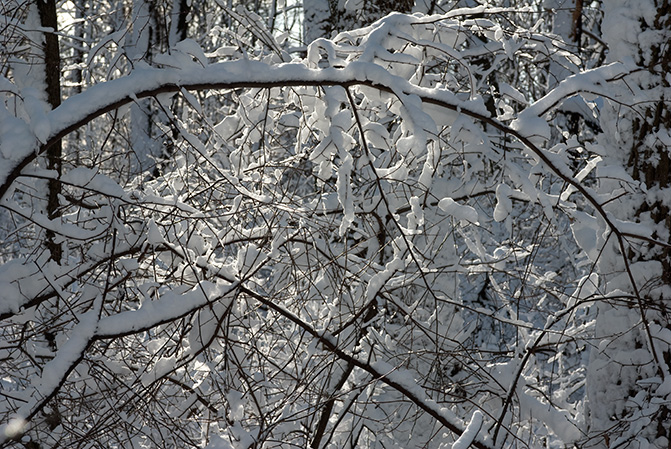 I recently attended a lecture on the art of ecological garden design and found a great deal of inspiration from the speaker’s ideology. I was reminded of the importance of a “sense of place.”
I recently attended a lecture on the art of ecological garden design and found a great deal of inspiration from the speaker’s ideology. I was reminded of the importance of a “sense of place.”
This is a design concept that has been around for years, but it was forcefully driven home with the reminder that a generic landscape—let’s say for the sake of simplicity a home surrounded by a green lawn—gives the viewer no sense of locality. You could be in Arizona, Alaska, Alabama, or anywhere in between.
With it comes the poignant reminder that we “no longer know where we are” and lose a sense of “who we are.” There is a loss of culture and tradition that disappears with the absence of locality.
Every part of the country has its own particular flavor.
If you are looking out your window and you see the knobby trunk of a pitch pine (Pinus rigidia), a beach plum (Prunus maritima), and expansive carpets of bearberry (Arctostaphylos uva-ursi) and broom crowberry (Corema conradii) covering sandy soil, then you are probably on Cape Cod. This is an image that is laden for many with certain associations, smells, and memories—generally good ones.
It is a memory of a diverse environment. This guru on ecological garden design reminded me that the experientially rich environment is full of textures, colors, movement, and sounds. With diverse plant palates comes the concomitant diversity in wildlife—the welcome as well as the unwelcome kind.
Monocultures often appear to be static and sterile, while one of the greatest joys of a natural environment is its dynamic system that celebrates seasonality. If beauty and abundance is not enough to convince the reader of the importance of diversity, then know that an ecological garden works with its surrounding rather than against it so is much less of a maintenance challenge. It certainly doesn’t require the quantity of chemicals that we have to dump into our lawns to keep them green.
Does this mean we should do away with the generic lawn? Certainly not! I would hate to lose the spot for the lawn chair, the badminton game, or the barbeque. With a little planning we can have the best of both worlds—patches of organically maintained lawn woven into a diverse and ecologically sound garden. This is how we can flourish and grow into the future.
Posted in Learning Experiences, Shop/Book Reviews on December 19 2008, by Plant Talk
Recipes for Holiday Gift Giving
 John Suskewich is Book Manager for Shop in the Garden.
John Suskewich is Book Manager for Shop in the Garden.
See the high accolades given to the Shop’s book section by the Financial Times of London.

I suffer from an edible complex: I am always thinking about eating! So I find myself irresistibly drawn to the food section of the bookstore, checking out the display copies of new cookbooks to see how the recipes stack up: One of the perks of the clerk. This is how I’ve come up with a number of recommendations for holiday gift giving for the foodies in your family!
Anyone who looks forward to putting on their annual winter layer of fat will be pleased with A Year in Chocolate. In this month-by-month guide to cooking with cacao, noted New York chocolatier Jacques Torres has adapted for the home cook his exquisite, indulgent desserts full of butter and cream with explicit but not complicated instructions. I love fine eating, but I still ignored all the ones that called for tempered chocolate and headed right for the brownies and the poached pears with chocolate sauce. The chocolate cookie that includes ancho chili powder among the ingredients is a real sweet slap in the face!
 Okay, the New York dead of winter is not the right time to think of farmers markets, but Outstanding in the Field, by Jim Denevan, with its seasonal and market-based recipes, summons up summer in a dish so evocatively you’ll be living in July in perpetuity. These recipes derive from the impromptu farm dinners created by Mr. Denevan and his fellow foodies for their unique, eponymous organization Outstanding in the Field, which goes across the country creating locavore versions of ’60s-style happenings, eat-ins maybe? I don’t know if they’ll ever come to the Bronx, but you can re-create the experience with the corn chowder, spinach gnocchi, and the free-range chicken dishes described here. Not until the roast turkey do you find a recipe that goes on for more than two pages. But if you’re like me you’ll read it, think “How interesting,” and then accept the invitation to dine at your sister’s for the holiday feast.
Okay, the New York dead of winter is not the right time to think of farmers markets, but Outstanding in the Field, by Jim Denevan, with its seasonal and market-based recipes, summons up summer in a dish so evocatively you’ll be living in July in perpetuity. These recipes derive from the impromptu farm dinners created by Mr. Denevan and his fellow foodies for their unique, eponymous organization Outstanding in the Field, which goes across the country creating locavore versions of ’60s-style happenings, eat-ins maybe? I don’t know if they’ll ever come to the Bronx, but you can re-create the experience with the corn chowder, spinach gnocchi, and the free-range chicken dishes described here. Not until the roast turkey do you find a recipe that goes on for more than two pages. But if you’re like me you’ll read it, think “How interesting,” and then accept the invitation to dine at your sister’s for the holiday feast.
 There is no point in trying to ignore the Barefoot Contessa, a.k.a. Ina Garten, whose latest cookbook is Back to Basics. She is as irresistible as the brownie pudding there on page 218. The subtitle is “fabulous flavor from simple ingredients,” but it is the element of subtle sophistication that sets her recipes apart. BC’s BLTs add avocado; roasting replaces poaching in her shrimp cocktail; caramelized onions fillip the burger. When she says “This version has always been my favorite but…” and then she tweaks it with one ingredient or maybe two, or some technical change…and the dish is transformed! She makes it look easy, but that inventiveness takes years of practice.
There is no point in trying to ignore the Barefoot Contessa, a.k.a. Ina Garten, whose latest cookbook is Back to Basics. She is as irresistible as the brownie pudding there on page 218. The subtitle is “fabulous flavor from simple ingredients,” but it is the element of subtle sophistication that sets her recipes apart. BC’s BLTs add avocado; roasting replaces poaching in her shrimp cocktail; caramelized onions fillip the burger. When she says “This version has always been my favorite but…” and then she tweaks it with one ingredient or maybe two, or some technical change…and the dish is transformed! She makes it look easy, but that inventiveness takes years of practice.
There you go. We’re really into food this season, and we’ll be expanding the selection as we ramp up to our big summer show on edible gardens. Stay tuned for details. Can’t wait for the okra to come in!
For more gift-giving ideas, view the Shop in the Garden staff’s favorite picks.
Also the Holiday Train Show is in full swing!
Check out Saturday’s programming
Check out Sunday’s programming
Posted in Exhibitions, Gardens and Collections, Holiday Train Show on December 18 2008, by Plant Talk
 |
Karen Daubmann is Director of Exhibitions and Seasonal Displays. |
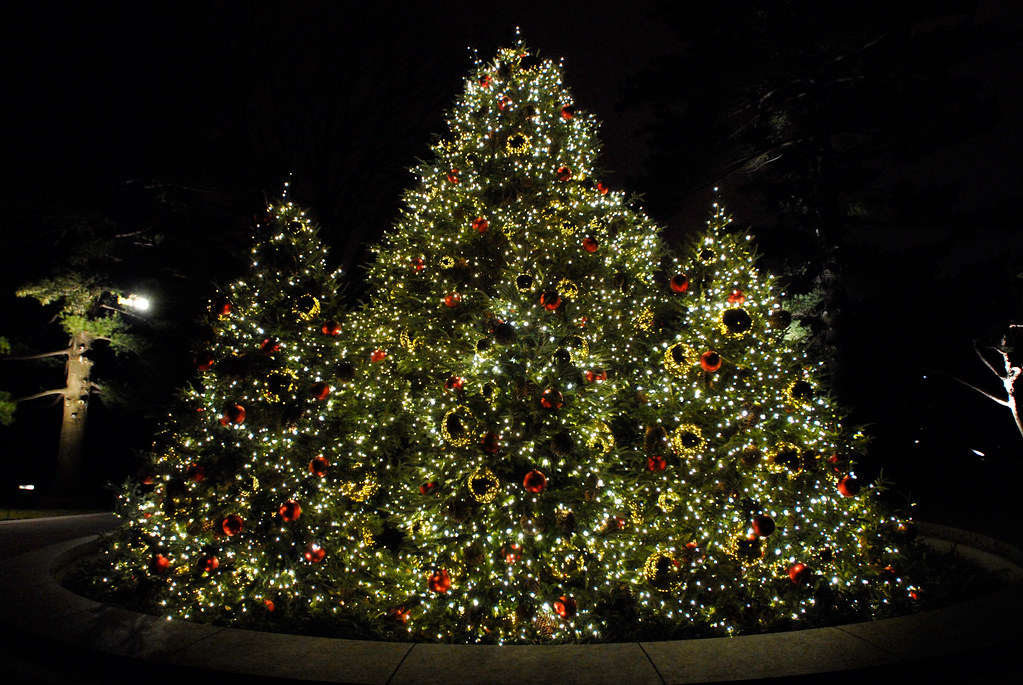 Planning for the holiday celebrations at the Garden starts long in advance. At this time last year the holiday display in the Reflecting Pool in the Leon Levy Visitor Center was evaluated and decisions were made concerning additions, deletions, and upgrades for this year’s display.
Planning for the holiday celebrations at the Garden starts long in advance. At this time last year the holiday display in the Reflecting Pool in the Leon Levy Visitor Center was evaluated and decisions were made concerning additions, deletions, and upgrades for this year’s display.
In August, our Director of Arboretum, Grounds, and Gardens, Kurt Morrell, traveled to the mountains of North Carolina to select the trees that would be used. Since big trees are hard to come by, the location of the farm must be kept a secret. We use a 28-foot tree in the center, surrounded by eight smaller trees. Always working well in advance of each project, Kurt has earmarked several trees that are being groomed for the years to come. Fraser fir, Abies fraseri, is his tree of choice. It lasts well from mid-November through mid-January, has nice structure and color, and the branches are stiff enough to support the weight of the large ornaments and the huge pine cones, which are from Pinus lambertiana, sugar pine, native to California.
To reduce energy use, we decided to change over to LED lights this year; the orders had to be placed earlier than usual, beginning in early summer. The lights arrived by early autumn and awaited installation—more than 19,000 bulbs just for the Reflecting Pool trees. Vendors were selected for the lighting and the decorating, and all waited for the November 10 arrival of the trees, ready to put the plan in motion.
The trees left North Carolina early Saturday morning, November 8, on a special, extra-long trailer. They arrived at the Garden two mornings later and were met by a crew from the outdoor gardens staff and a large crane. After the trees were placed in special steel tree stands, the crew from Frost Lighting leaped into action. It took three days to add the LED light strings to the trees. Meanwhile, the crew from Bowman Dahl Floral and Event Design arrived to clean and prep the ornaments, both those that were recycled from past shows and those that would be new additions.
Just five days after delivery, the vignette of trees was ready for its unveiling.
Posted in Learning Experiences, Programs and Events on December 17 2008, by Plant Talk
 |
Jeff Downing is Vice President for Education. |
When I was a kid growing up in rural Newtown, Connecticut, my best friend, Cliff, and I climbed trees. We were good. We could shimmy, twist, and scamper our way to the highest branches that would support our meager weight. From there, we would survey the neighborhood like forest rangers as the treetop swayed. (We never understood why our moms cried in horror whenever they discovered us happily perched 30 feet above our roofs.) Those were the days.
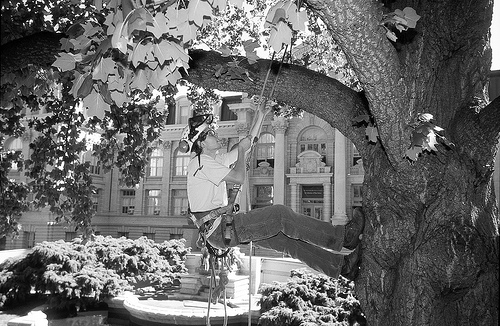 If someone had told me then that you could actually make a career out of climbing trees, I would have said, “Where do I sign up?” And now, when I speak with passionate recreational gardeners about the frustrating shortage of skilled horticulturists, many respond with similar wide-eyed surprise: “You mean I could do this for a living?”
If someone had told me then that you could actually make a career out of climbing trees, I would have said, “Where do I sign up?” And now, when I speak with passionate recreational gardeners about the frustrating shortage of skilled horticulturists, many respond with similar wide-eyed surprise: “You mean I could do this for a living?”
But the fact is that arborists and horticulturists of every description are truly in demand, and have been for some time. Botanical gardens, municipal parks departments, estate managers, and landscape design/building firms all lament the shortage of trained professionals, from entry level gardeners to horticulture directors and executives. And the best I can figure, it is largely for lack of public awareness that these career tracks actually exist!
The New York Botanical Garden’s Continuing Education program and School of Professional Horticulture have trained generations of the world’s finest horticulturists for over 80 years. Now, certificates are offered in seven disciplines, including horticulture, landscape design, floral design, and horticultural therapy.
But in this economy, will there be jobs? I can’t tell the future, but I know the history—too few trained professionals for too long. And I know the present—trees still need to be pruned, gardens still need love and care. Look up the New York City Parks Department’s Career Opportunities, for just one example. Then go to our Continuing Education Web page and register online for an introductory class (or call us at 1-800-322-NYBG for guidance). The Garden’s classes are like potato chips: I bet you can’t take just one.
Posted in NYBG in the News on December 16 2008, by Plant Talk
 Carol Capobianco is Editorial Content Manager at The New York Botanical Garden.
Carol Capobianco is Editorial Content Manager at The New York Botanical Garden.
 Each day in the media we are made aware of the harm being done to the environment due to climate change, invasive species, overuse of natural resources, and clear-cutting of forests. Gardeners can make a difference—in the way they design and manage the landscape.
Each day in the media we are made aware of the harm being done to the environment due to climate change, invasive species, overuse of natural resources, and clear-cutting of forests. Gardeners can make a difference—in the way they design and manage the landscape.
Today, Plant Talk introduces a companion blog, Green Perspectives: Tom Christopher on Sustainable Gardening, to offer gardeners solutions and ideas on how to help the environment. Veteran garden writer Tom Christopher has been gardening and writing for more than 30 years and is a graduate of NYBG’s School of Professional Horticulture. He will take you along with him as he explores, investigates, and tests different ways and methods of restoring Earth through our passion for earth.
The New York Botanical Garden, as a premier plant research and cultural institution, is working to address conservation concerns both here at the Garden and around the world. The Garden’s sustainability and climate change initiatives include improving operational efficiencies and energy use, reviewing horticultural practices, presenting educational programs and symposia, conducting biodiversity research, and providing scientific advice to conservation organizations.
To find Tom Christopher’s blog posts, click on the “Green Perspectives” tab above. Be sure to visit often and to share your comments. Let us know what has worked for you. Together we can make a difference.
Posted in Gardening Tips on December 15 2008, by Sonia Uyterhoeven
Growing Herbs Indoors
 Sonia Uyterhoeven is Gardener for Public Education at The New York Botanical Garden.
Sonia Uyterhoeven is Gardener for Public Education at The New York Botanical Garden.
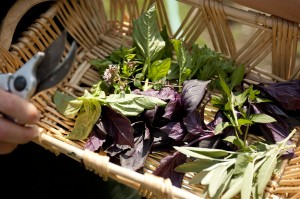 As winter winds chill your bones, some of your summer pastimes can be successfully re-created in the home. One of my favorites is growing herbs on a windowsill. My biggest challenge is overuse. Healthy plants get nightly haircuts until they dwindle into a small patch of nothingness.
As winter winds chill your bones, some of your summer pastimes can be successfully re-created in the home. One of my favorites is growing herbs on a windowsill. My biggest challenge is overuse. Healthy plants get nightly haircuts until they dwindle into a small patch of nothingness.
For those of you who are able to exercise better restraint, many herbs can be grown indoors and will happily survive on a sunny windowsill. Basil, chives, parsley, thyme, and oregano are easy to grow. Rosemary is trickier to grow as it needs a cool room (around 60°F) and high humidity. Most herbs require six hours of sunlight to thrive. Bright southern or western exposure is best. Parsley, rosemary, and mint can take less light.
All herbs are unhappy with the dry, stagnant air common in homes during the winter months. Some antidotes: occasionally crack open a window or periodically run a small oscillating fan; keep household temperatures in the 70s; mist plants daily, place them on top of a pebble tray, or invest in a humidifier that will benefit both you and your green guests.
Use water at room temperature for herbs. Some such as marjoram, oregano, sage, and thyme need to dry out between watering—meaning when the soil surface is dry. Rosemary and mint will resent dry periods and shouldn’t be allowed to completely dry out. Make sure that water doesn’t collect or sit on the leaves of your herbs, otherwise they will rot. Basil is particularly susceptible.
Indoor herbs, like all of your houseplants, will gather dust and will require an occasional bath. Take a soft sponge or paper towel and clean the leaves. Alternatively, gently run it under the shower or the tap. While herbs don’t need fertilizing when they are growing outdoors, a monthly boost of half-strength fish emulsion will help keep your winter windowsill herbs thriving.
If the herbs are moving from outdoors to indoors they should be potted up before the first frost. If they undergo a reverse hardening off procedure they will have a better chance of adjusting to your home environment. Place the containers in a slightly shady area for a week to prepare them to the lower light levels of the home. Gradually bring them in for a few hours every day until you are ready to provide them with a new home.
When bringing your herbs indoors from the garden, many will benefit from being cut back by half. Some examples are rosemary, mint, sage, thyme and oregano. Remember that herbs love haircuts—it keeps the growth nice and tender and tasty. Growing herbs in your home is fairly easy; the hardest choices you will face is whether you should put them in your salad or on the roasted chicken.
Posted in Learning Experiences, Programs and Events, Wildlife on December 12 2008, by Plant Talk
Here’s What You May See on the Tally
 |
Debbie Becker leads a free bird walk at the Garden every Saturday from 11 a.m. to 12:30 p.m., beginning at the Reflecting Pool in the Leon Levy Visitor Center. Join her tomorrow, December 13, for the 2008 New York Botanical Garden Bird Count. |
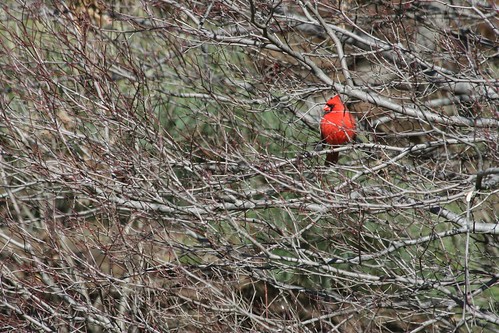 Every year at this time, birders flock to the parks and woods across the country and beyond for National Audubon Society’s annual Christmas Bird Count. From dawn’s early light until dusk birders count all the birds they can find using a specific method and within precise geographic areas. At the end of the day the counts are tallied and compared to numbers from previous years. The information is used to determine if a bird species is in trouble or declining. Past revelations included lower than usual numbers of house finches, most likely due to conjunctivitis, and decimated crow numbers, presumably due to West Nile Virus. Occasionally, a rarity will pop up on the count as birders scour the shorelines, forests, and meadows looking for elusive visitors to their areas. Past special sightings at the Botanical Garden, which is part of Audubon’s 84-year-old Bronx-Westchester count, include common redpolls, chipping sparrows, pine warblers, Baltimore orioles, and a merlin.
Every year at this time, birders flock to the parks and woods across the country and beyond for National Audubon Society’s annual Christmas Bird Count. From dawn’s early light until dusk birders count all the birds they can find using a specific method and within precise geographic areas. At the end of the day the counts are tallied and compared to numbers from previous years. The information is used to determine if a bird species is in trouble or declining. Past revelations included lower than usual numbers of house finches, most likely due to conjunctivitis, and decimated crow numbers, presumably due to West Nile Virus. Occasionally, a rarity will pop up on the count as birders scour the shorelines, forests, and meadows looking for elusive visitors to their areas. Past special sightings at the Botanical Garden, which is part of Audubon’s 84-year-old Bronx-Westchester count, include common redpolls, chipping sparrows, pine warblers, Baltimore orioles, and a merlin.
Twenty years ago I started the Garden’s own unofficial bird count, a low-keyed version that is fun and educational. Instead of gathering at 5 a.m., we meet at 11 a.m. and set out to count the birds at NYBG. I keep a list of the most common New York City birds and put strokes near their names as we spot them flying by. The two decades of data from our informal count confirms the trends found in the Audubon count.
Read about the birds likely to be found on the count and of a special sighting last year after the jump.
UPDATE 12/18/08: Bird walk results
Count day was sunny and cold, with temperatures in the 20s. Nineteen people participated; the count lasted three hours and turned up 24 species and 105 birds overall. Highlights of the day included a northern shoveler at Twin Lakes, both the female and male great horned owls in the Forest, and a goshawk, for the second year in a row, by the Prop Range. A flock of house finches, a brown creeper, and a house wren also were good finds. The full list is noted here.
House finch: 12; House sparrow: 3; White-throated sparrow: 5; Black-capped chickadee: 8; Dark-eyed junco: 15; House wren: 1; American crow: 1; Blue jay: 2; Northern cardinal: 2; Mourning dove: 9; American robin: 3; Red-bellied woodpecker: 1; Downy woodpecker: 1; Tufted titmouse: 3; White-breasted nuthatch: 1; Brown creeper: 1; Northern mockingbird: 3; Hermit thrush: 2; Great horned owl: 2; Red-tailed hawk: 2; Northern goshawk: 1; Northern shoveler: 1; Mallard: 23; Hooded merganser: 3; (Last week, 30 wood ducks were counted.)